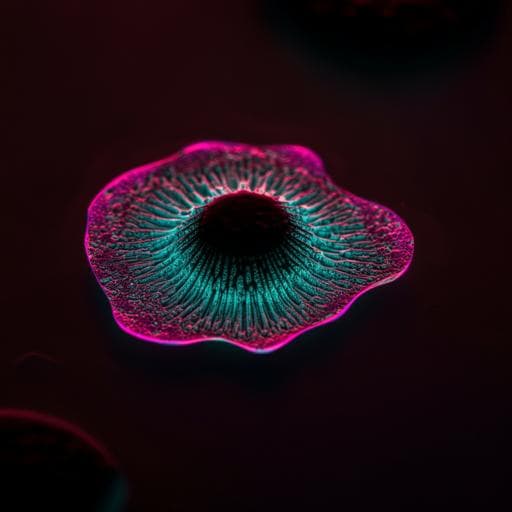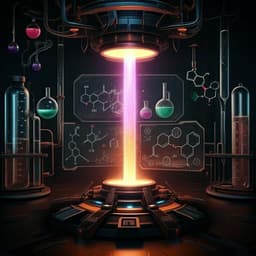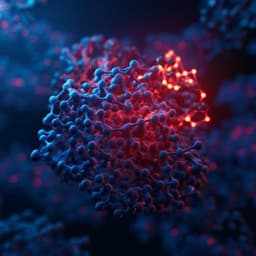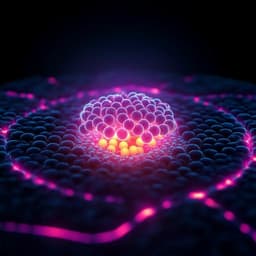
Chemistry
Light-induced tumor theranostics based on chemical-exfoliated borophene
Z. Xie, Y. Duo, et al.
Discover a groundbreaking chemical etching method to create borophene with remarkable near-infrared light-induced photothermal effects! Conducted by a team of experts including Zhongjian Xie and Yanhong Duo, this research presents a biocompatible nanoplatform (B@PDA) that revolutionizes photothermal theranostics for tumors, offering a safer alternative to gold nanoparticles.
~3 min • Beginner • English
Introduction
The study addresses the challenge of fabricating borophene, a lightweight 2D material with distinctive metallic and semiconducting polymorphs and promising optical and thermal properties, for biomedical theranostics. Conventional bottom-up growth (MBE on Ag(111), CVD on Cu) and prior top-down methods (thermal oxidation/liquid-phase exfoliation, sonochemical exfoliation of bulk boron) face constraints due to boron’s covalent bonding and non-layered structure. The authors propose and investigate a top-down selective chemical etching of AlB₂ to produce ultrathin borophene nanosheets exhibiting strong near-infrared absorption for photothermal therapy and photoacoustic imaging. The purpose is to develop a degradable, biocompatible nanoplatform (via PDA modification) for light-induced tumor theranostics, potentially overcoming long-term toxicity associated with non-degradable plasmonic nanoparticles like gold, and leveraging borophene’s high thermal transport and optical properties for deep-tissue applications.
Literature Review
The introduction surveys the rapid development of photonics in medicine and the rise of 2D nanomaterials (graphene derivatives, MoS₂, MXenes, black phosphorus, bismuthene, antimonene, tellurene, selenene, 2D metals, MOFs). Borophene has drawn attention for its polymorphism, anisotropy, metallicity (suitable for transparent electrodes), and potential semiconducting phases (e.g., γ-B28 monolayer with PL ~626 nm). Prior fabrication routes include bottom-up MBE on Ag(111) and CVD on Cu foils, and top-down methods via thermal oxidation plus liquid-phase exfoliation or sonochemical exfoliation of bulk boron, reflecting difficulties arising from boron’s covalent network. These methods have limitations in scalability, structural integrity, and application readiness. The study builds on MXene-like selective etching strategies to overcome these limitations for borophene.
Methodology
- Materials synthesis: Employed selective acid etching of AlB₂ precursor. Compared HCl and HF etching behaviors. HCl etches away Al layers, leaving a boron lattice; HF etches B, yielding aluminum-based nanosheets. Mild etching conditions were used to preserve structure. Post-etch sonication exfoliated products into ultrathin, large-area nanosheets.
- Morphology and structure characterization: XRD to monitor phase changes (disappearance of AlB₂ peaks and emergence of low-angle peaks at 2θ ~6° for HCl-etched B product; HF products resemble AlF₃ and Al₂O₃ with strong peak near 2θ ~8°). XPS to confirm elemental composition (HCl product predominantly B; HF product Al, O, F). STEM-EDS mapping and quantitative EDS to assess elemental distributions and weight percentages (HCl product ~95.88 wt% B; HF product lacks B). SEM and TEM to visualize morphology (book page-like structures post-etch; hexagonal nanosheets after sonication). AFM to measure thickness (~4 nm). HRTEM and SAED to identify lattice spacings and phases, revealing mixed β12 (d ~0.54 nm) and χ3 (d ~0.26 nm) phases.
- Surface modification: Coating borophene with polydopamine (PDA) to enhance biocompatibility, stability, and NIR absorption, forming B@PDA. A Cy5 fluorophore was conjugated for cellular uptake studies (Cy5-B@PDA).
- Optical and photothermal characterization: UV–vis–NIR absorption to determine extinction coefficients: naked borophene k ~6.0 L g^-1 cm^-1; B@PDA k ~6.5 L g^-1 cm^-1 at 808 nm. Photothermal tests under 808 nm irradiation measured temperature rise and cycling stability (six on/off cycles) and computed photothermal conversion efficiency (η ~32%). Stability and degradability assessed by monitoring absorbance decrease after irradiation and performance decay across cycles. Photothermal performance under 1064 nm (NIR-II) irradiation was also examined (weaker than at 808 nm). pH-dependent performance tested to simulate tumor microenvironment (acidic pH slightly affects properties, likely due to accelerated degradation).
- In vitro assays: Cytotoxicity (CCK-8) in multiple tumor cell lines (HCT-116, HeLa, A549, MCF7) and noncancerous cells across 25–500 ppm B@PDA for 48 h. Photothermal therapy experiments: cells incubated with B@PDA for 4 h, irradiated with 808 nm laser at 1 W cm^-2 for 10 min, followed by 24 h incubation; viability measured by CCK-8. Live/dead staining (Calcein-AM for live, PI for dead) imaged by LSCM. Cellular uptake/endocytosis: LSCM tracking of Cy5-B@PDA at pH 7.4 vs 6.5 at 15 min and 3 h; mitochondrial colocalization assessed; ROS-related mechanistic exploration initiated (ROS production in HCT-116 following B@PDA treatment and irradiation).
Key Findings
- Selective etching outcome: HCl selectively removes Al from AlB₂ to yield boron nanosheets (borophene); HF removes B, producing aluminum-based sheets (AlF₃/Al₂O₃-like). EDS quantification shows HCl-etched product contains ~95.88 wt% B; HF-etched product contains Al, O, F with no B.
- Morphology and structure: Post-etch, materials exhibit book page-like morphology; sonication yields large, ultrathin borophene nanosheets with lateral sizes up to hundreds of nm (reported up to ~600 nm) and thickness ~4 nm by AFM. TEM/SAED/HRTEM indicate mixed β12 and χ3 polymorphs.
- Optical properties: Naked borophene shows strong NIR absorption with extinction coefficient k ~6.0 L g^-1 cm^-1 at 808 nm, higher than gold nanorods (~3.9) and antimonene (~3.6) and comparable to Ge nanosheets (~5.962). PDA coating further increases k to ~6.5 L g^-1 cm^-1 at 808 nm.
- Photothermal performance: B@PDA exhibits rapid temperature rise under 808 nm irradiation and a photothermal conversion efficiency of ~32%, surpassing reported MoS₂ and Ti₃C₂ nanosheets. Performance decays gradually over six irradiation cycles, consistent with degradability; absorbance also decreases after irradiation. B@PDA shows weaker photothermal response under 1064 nm (NIR-II) than at 808 nm. Acidic pH slightly affects photothermal behavior, likely via accelerated degradation.
- Biocompatibility and therapy: B@PDA shows low cytotoxicity across multiple tumor cell lines up to 500 ppm after 48 h. Under 808 nm irradiation (1 W cm^-2, 10 min) following 4 h incubation, B@PDA induces dose-dependent photothermal killing in HCT-116, HeLa, A549, and MCF7 cells; pure PDA shows negligible killing under the same conditions. Live/dead staining confirms effective ablation.
- Tumor microenvironment responsiveness and uptake: PDA imparts pH-responsiveness; cellular uptake of Cy5-B@PDA is enhanced at pH 6.5 vs 7.4 after 3 h, indicating improved accumulation in acidic tumor conditions. Cy5-B@PDA localizes to mitochondria, potentially facilitating ROS-mediated mechanisms of cell death.
Discussion
The study demonstrates a scalable top-down route to borophene by selective acid etching of AlB₂, analogous to MXene fabrication, overcoming challenges posed by non-layered boron. The discovery that HCl yields borophene (by removing Al) while HF yields aluminum-based sheets (by removing B) reveals complementary etching selectivity that can guide synthesis from other borides. The resulting borophene nanosheets possess strong NIR absorption and high photothermal conversion efficiency, and when coated with PDA form a biocompatible, tumor microenvironment-responsive platform. Compared to non-degradable plasmonic Au nanoparticles, borophene’s degradability reduces concerns about long-term accumulation and toxicity, while maintaining effective photothermal performance for cancer therapy and photoacoustic imaging. Enhanced uptake in acidic environments and mitochondrial localization suggest efficient intracellular delivery and potential multimodal mechanisms (thermal and ROS-related) for tumor ablation. Overall, the findings support borophene as a promising degradable photothermal theranostic agent with deep-tissue NIR activation and potential translational advantages.
Conclusion
This work introduces a selective chemical etching strategy to fabricate ultrathin, large-area borophene nanosheets from AlB₂, revealing opposite etching selectivity of HCl (producing borophene) versus HF (producing Al-based sheets). The as-prepared borophene exhibits strong NIR absorption, and PDA modification yields a biocompatible B@PDA platform with high photothermal conversion efficiency (32%), robust in vitro tumor cell ablation under 808 nm irradiation, enhanced cellular uptake in acidic conditions, and evidence of degradability. These attributes indicate borophene’s suitability for safe, effective light-induced tumor theranostics. Future research can explore extending this top-down selective etching to the broader family of ~40 borides to access diverse borophene polymorphs; optimizing stability–degradability trade-offs; improving NIR-II performance; elucidating detailed mechanisms (including ROS contribution and subcellular targeting); and conducting comprehensive in vivo efficacy, biodistribution, clearance, and safety studies.
Limitations
- The photothermal performance of B@PDA decays over repeated irradiation cycles, indicating structural degradation that may limit repeated treatment protocols.
- Photothermal response under NIR-II (1064 nm) is weaker than at 808 nm, potentially restricting deeper-tissue applications without further optimization.
- Acidic conditions slightly affect performance, likely due to accelerated degradation, which may impact efficacy in heterogeneous tumor microenvironments.
- The reported biological evaluation in the provided text is limited to in vitro assays; additional in vivo validation, long-term safety, and clearance studies are needed to generalize therapeutic potential.
Related Publications
Explore these studies to deepen your understanding of the subject.







